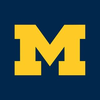
Overview
Founded in 1817, the University of Michigan is a non-profit public higher education institution located in the urban setting of the small city of Ann Arbor (population range of 50,000-249,999 inhabitants), Michigan. This institution also has a branch campus in Dearborn and Flint. Officially accredited by the Higher Learning Commission, University of Michigan (U of M) is a very large sized (uniRank enrollment range: over-50,000 students) coeducational US higher education institution. University of Michigan (U of M) offers courses and programs leading to officially recognized higher education degrees in several areas of study. See the uniRank degree levels and areas of study table below for further details. This 207-year-old US higher-education institution has a selective admission policy based on entrance examinations and students' past academic records and grades. The acceptance rate range is 10-19% making this US higher education organization an extremely selective institution. International students are welcome to apply for enrollment. U of M also provides several academic and non-academic facilities and services to students including a library, housing, sports facilities, financial aids and/or scholarships, study abroad and exchange programs, online courses and distance learning opportunities, as well as administrative services.
University Snapshot
Control
![]() public
public
Entity
![]() non-profit
non-profit
Size
![]() very large sized
very large sized
Selectivity
![]() extremely selective
extremely selective
University Identity
| Name | University of Michigan |
|---|---|
| Name (English) | |
| Name (Non Latin) | |
| Acronym | U of M |
| Founded | 1817 |
| Motto | Artes, Scientia, Veritas Art, Science, Truth |
| Colours | Maize and blue |
| Mascot | |
| Screenshot |  |
| Video Presentation |
University Location
| Address | 503 Thompson Street Ann Arbor 48109 Michigan United States |
|---|---|
| Location Map and Satellite View | |
| (734) 764 1817 | |
| Other locations | Dearborn and Flint |





Social Media
Introduction
Social media can be a powerful tool for Universities to communicate with current students, alumni, faculty, staff and the wider community. But how can social media be important for prospective students? Read our article about the importance of Social Media for universities and prospective students to learn more.
Social Media
uniRank publishes brief reviews, rankings and metrics for some of University of Michigan's social media channels as a starting point for comparison and as an additional selection tool for potential applicants.
University of Michigan's Facebook page review
University of Michigan's X page review
University of Michigan's Youtube page review
University of Michigan's Instagram page review
University of Michigan's official LinkedIn profile
n.a.